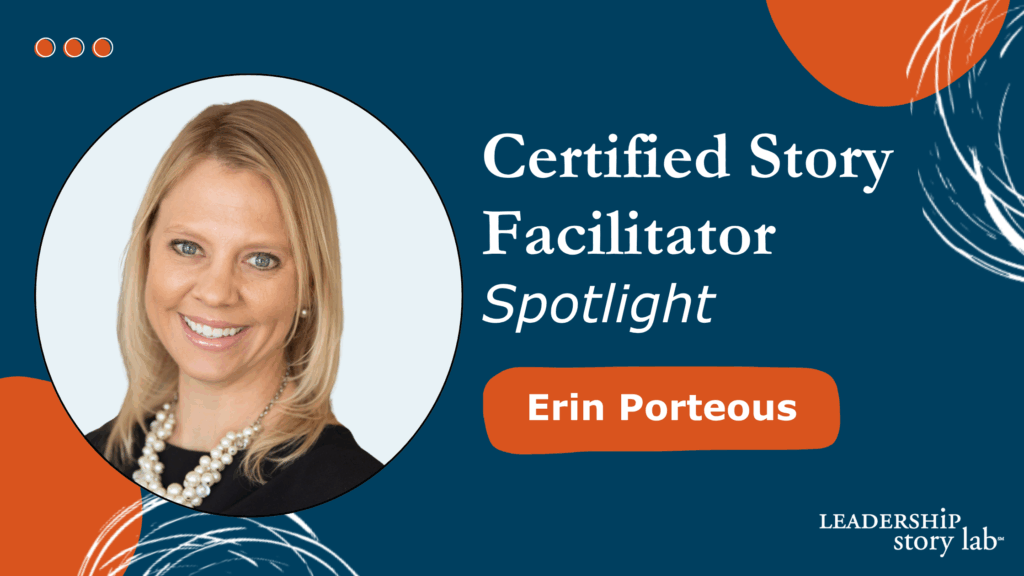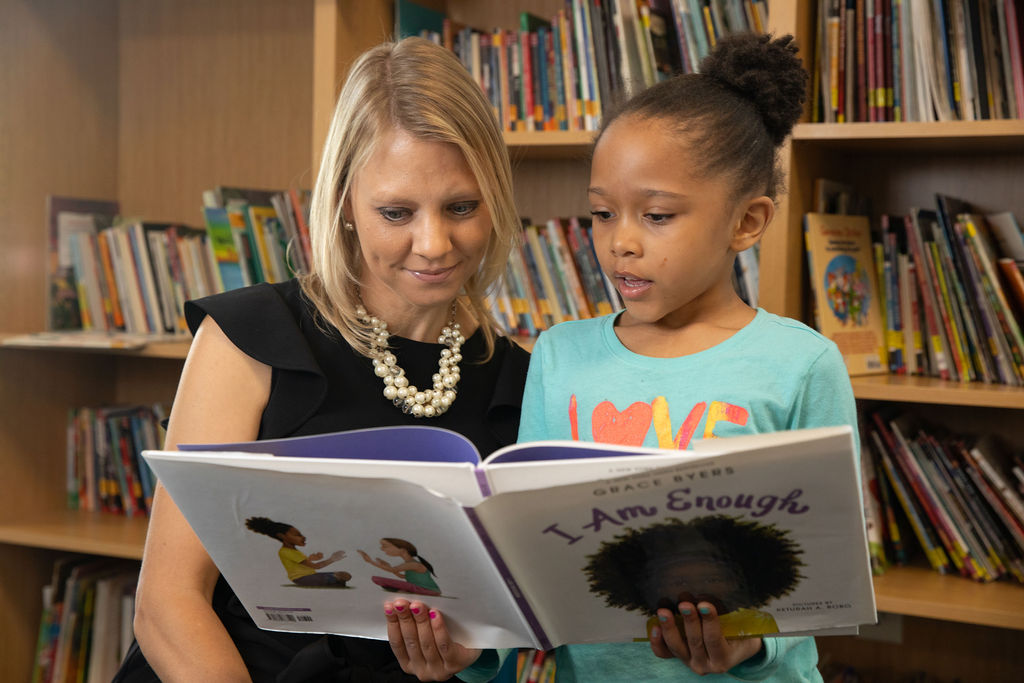October 8, 2025 / Leadership Story Lab
 When Erin Porteous started working for the Boys and Girls Club of Denver, she worked two jobs so that she could make ends meet. But because she loved the mission, she didn’t mind. Now as the CEO of the Boy and Girls Clubs of Denver, Colorado, Erin’s role is primarily fundraising — working with government officials, foundations, individual donors, corporations. The 25 Clubs in Denver serve families of school-age kids and teens as a key provider for afterschool programs and affordable summer childcare (as little as $1 a day!). When she needs to fill up her cup, she heads into a Club to spend time with kids in the art room, reading a book or playing a game.
When Erin Porteous started working for the Boys and Girls Club of Denver, she worked two jobs so that she could make ends meet. But because she loved the mission, she didn’t mind. Now as the CEO of the Boy and Girls Clubs of Denver, Colorado, Erin’s role is primarily fundraising — working with government officials, foundations, individual donors, corporations. The 25 Clubs in Denver serve families of school-age kids and teens as a key provider for afterschool programs and affordable summer childcare (as little as $1 a day!). When she needs to fill up her cup, she heads into a Club to spend time with kids in the art room, reading a book or playing a game.
Erin met Esther at a YPO retreat where Esther facilitated Paired Introductions, a storytelling workshop that focuses on active listening and the power of asking Crazy Good Questions to help write an intriguing introduction that can be used at conferences, meetings, and other networking events.
“I don’t have to tell you, Esther’s amazing, right?” Erin said when we met for an interview. “There’s an energy about her that you just want to be around.” After that conference, Erin learned about Leadership Story Lab’s Certified Story Facilitator (CSF) training where she could learn to facilitate Paired Introductions herself.
Leadership Story Lab: Why did you decide to sign up for CSF?
Erin: For a number of decades, I did long distance running. I learned over time that it was less about the race, and more about all the hours of training that happens before the race. But over time there’s a part of your brain that actually grows to desire the endurance phase: While it’s challenging and mentally and physically demanding, it’s also really rewarding.
I feel that way about public speaking and writing too, both are activities that require deep work, that are usually gratifying in the long-term but require long hours and ‘building the muscle’ of writing, editing, rewriting and finally presenting.
I’m in a job where there’s a lot of “being on” and public speaking. As a life long learner, I want to get better at presenting. I want to get better at listening. I want to get better at facilitating. Paired Introductions really hit on all of those skill sets so Esther’s workshop piqued my interest.

Leadership Story Lab: Do you have an example of how the training changed the way you understand your role as the CEO?
Erin: It’s helped modify my behavior. I’ve been in my role for a long time, which can make you stuck in your ‘old’ way. Someone can come up with an idea and sometimes my response is: I’ve seen that before. We’ve done it that way. But after CSF, I am moving more in a place of curiosity, especially around question asking.
CSF is set up to put you on a pathway of exploration and where you’re trying to get to isn’t always defined. Curiosity is what’s modeled and celebrated. I’ve gotten better at the skill set of approaching with curiosity, which I think has a really positive connotation.
Leadership Story Lab: Were there other outcomes from the CSF training?
Erin: Yes. Of my CSF cohort the other three participants are involved in media, journalism or cinematography. I was a real outsider in regards to working in a creative arena. What I look back on is the really different perspectives from mine. I felt very challenged in the exercises we did during the training.
What transferred over to my job is that I now feel more comfortable in settings where I may be out of my element or other people may know more. Active participation is still necessary and welcomed. I feel like that got strengthened through that experience in CSF.
Leadership Story Lab: What did you find particularly challenging about the training?
Erin: The model. You cannot hide. When there’s four people in the cohort, everyone will have to stand in the spotlight.
Also, I love Esther, and she has this persona “Nancy” that visits during the exercises. In my role, you don’t always get honest feedback, because there’s always power dynamics. So people might sugarcoat it or might not tell you the full truth. But in working with Esther (and her alter ego) you get the full truth. I really appreciated that part of CSF.

Esther’s disruptive “cousin” Nancy joins during different exercises in CSF. Nancy helps participants learn how to navigate facilitation when one of the participants has a challenging personality. Her less than cooperative style gives everyone in the program a chance to practice how to handle difficult people in real time, which outside training, we encounter all the time.
Leadership Story Lab: What was it like to lead your first Paired Introduction exercise?
Erin: Three things happened. First, I remember that I felt like I got in a position of being vulnerable, almost oversharing. Oversharing can be what you feel because you feel vulnerable. But I think it helped everybody let their guard down a bit. But then I was also sensitive to the fact that I’m the facilitator. We’re not here to hear my voice. We’re here to hear these other voices.
So that was the second thing that happened — I said to myself, OK, Erin, shut up.
The third thing that happened was listening. Facilitation requires such a high-level of listening skills. You have to fully absorb, and then you have to be able to real-time synthesize and move onto what’s next.
It was so helpful when Esther played her cousin because I had a real talker in my group. We were taken onto a tangent. I had to articulate and nicely rein it back in to get back on task.
Leadership Story Lab: What has it been like to introduce the culture of storytelling to your organization?
Erin: I led another Paired Introduction workshop with my fundraising team because storytelling about the importance of Boys and Girls Clubs is the most powerful thing we can do. We can come with all sorts of data and output statistics, but storytelling is the most powerful.
And then also asking questions of our donors so we can find out why they care about our cause and mission.
Impeccable storytelling requires being vulnerable, open, and participation in an exercise that probably feels far out of people’s realm in comparison to their daily life. But it’s also what people remember the most; perhaps for that very reason – because of what is required from them to truly show up in that moment.
I think it would be really powerful to do it also with our board of directors, because they have a totally different lens.They’re involved for different reasons, and they have fiduciary responsibilities and huge governing and fundraising responsibilities. It’d be really fun to lead them through that.
Leadership Story Lab has led the Paired Introduction workshop with leaders of all different personalities, across sectors. This workshop is so powerful because it gives leaders the structure to step away from cliches and the typical scripts that every industry and corporation has and allows people to see each other’s humanity.
Leadership Story Lab: Outside the CSF training what Leadership Story Lab resources have you found most helpful?
Erin: I love Esther’s monthly email. In May, she shared about how to give a great toast or great speech. And I loved it because I often find myself in the settings where people ask me, Erin, Say something nice about this person.
Then I’m like, Oh my gosh, how do I put that together quickly?
Esther gives advice that I use in public speaking sessions; including toasts, large group speeches, and even in very special occasions where I am sharing during someone’s celebration of life. Her monthly emails give bite-size advice that you can immediately put into action.
Leadership Story Lab: How is CSF compared to other professional development courses you’ve done?
Erin: I liked CSF because it’s hands-on. Leading is like a muscle I use all the time, but I’m not always strengthening it. I’m not making it better. CSF really allows for strengthening the muscle. How do we ask deeper questions? How do we facilitate better? How do you become a better facilitator and not just insert your opinion into things? How do you watch the room?
I love how CSF makes you very conscious of nonverbal. What’s happening — where are the pauses? How do you draw people in? Those elements make me a better leader. So while it’s related to facilitation and presentation and writing, I think they’re all leadership skills.
Leadership Story Lab: Can you share more about that? How do these curiosity and these skills make you a better leader?
Erin: Leading is really about casting a vision about something that you believe in. And in my case, the Boys and Girls Clubs and serving kids and providing affordable afterschool care. You can have the best cause, but if you can’t get people to rally behind your story, it doesn’t matter.
There are many amazing nonprofits out there, but they don’t have the infrastructure or the ability to really communicate why they matter.
CSF makes me a better leader. Now I’m quieter in group settings so I can hear what everyone has to share. I’m more inquisitive. How do I find out what really makes people come to the table? I turn off the ‘I’ve got the answer’ for curiosity and reflection.
That’s how it really plays into leadership.
Related Articles
What Happen When Leadership Storytelling Easily Sparks Connection
Better Every Story
Leadership Transformation through Storytelling
"This is an amazing and insightful post! I hadn’t thought of that so you broadened my perspective. I always appreciate your insight!" - Dan B.
Get Esther Choy’s insights, best practices and examples of great storytelling to your inbox each month.




